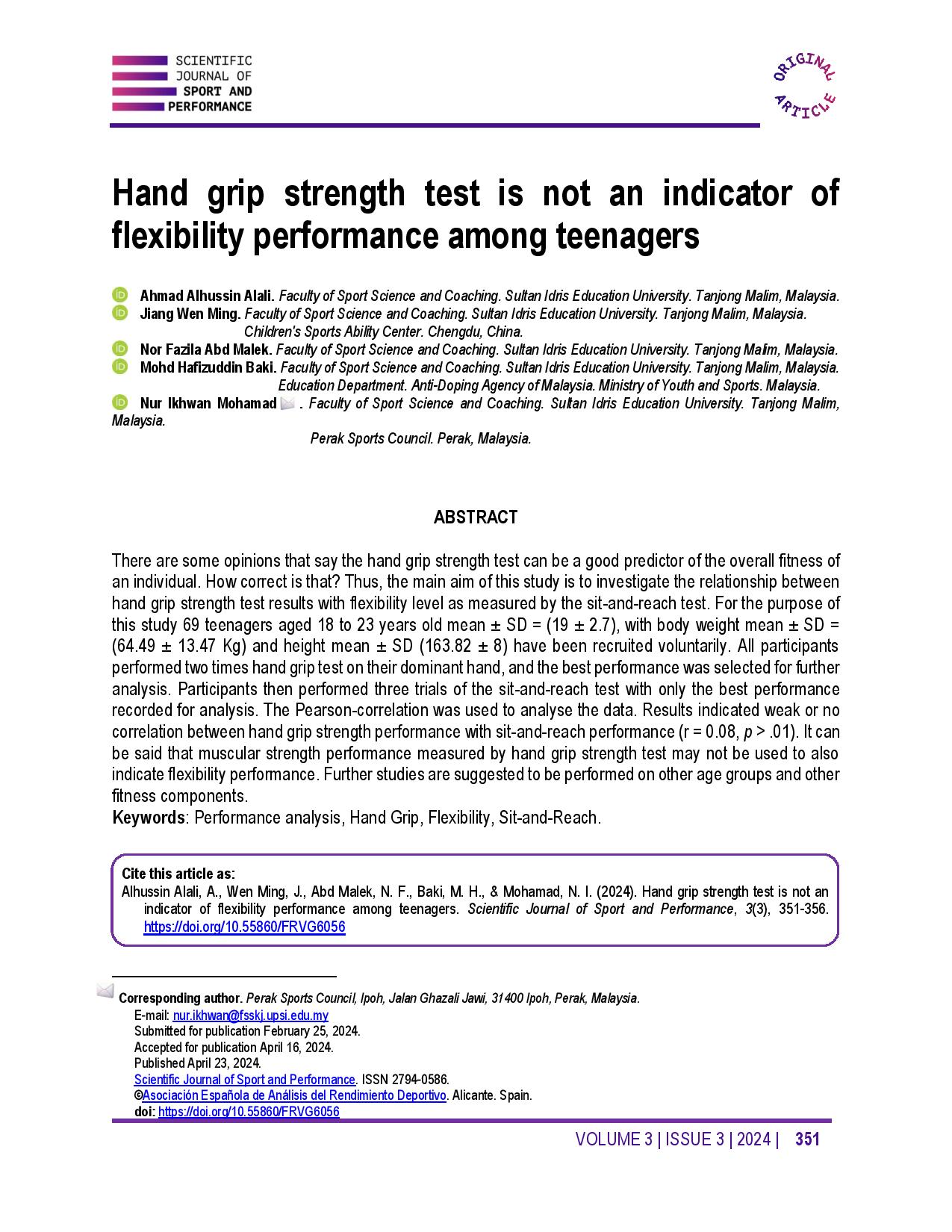Hand grip strength test is not an indicator of flexibility performance among teenagers
Main Article Content
Abstract
There are some opinions that say the hand grip strength test can be a good predictor of the overall fitness of an individual. How correct is that? Thus, the main aim of this study is to investigate the relationship between hand grip strength test results with flexibility level as measured by the sit-and-reach test. For the purpose of this study 69 teenagers aged 18 to 23 years old mean ± SD = (19 ± 2.7), with body weight mean ± SD = (64.49 ± 13.47 Kg) and height mean ± SD (163.82 ± 8) have been recruited voluntarily. All participants performed two times hand grip test on their dominant hand, and the best performance was selected for further analysis. Participants then performed three trials of the sit-and-reach test with only the best performance recorded for analysis. The Pearson-correlation was used to analyse the data. Results indicated weak or no correlation between hand grip strength performance with sit-and-reach performance (r = 0.08, p > .01). It can be said that muscular strength performance measured by hand grip strength test may not be used to also indicate flexibility performance. Further studies are suggested to be performed on other age groups and other fitness components.
Article Details

This work is licensed under a Creative Commons Attribution-NonCommercial-ShareAlike 4.0 International License.
References
Beunen, G., & Malina, R. M. (1988). Growth and physical performance relative to the timing of the adolescent spurt. Exercise and sport sciences reviews, 16, 503-540. https://doi.org/10.1249/00003677-198800160-00018 DOI: https://doi.org/10.1249/00003677-198800160-00018
Brazo-Sayavera, J., Aubert, S., Barnes, J. D., González, S. A., & Tremblay, M. S. (2021). Gender differences in physical activity and sedentary behavior: Results from over 200,000 Latin-American children and adolescents. PloS one, 16(8), e0255353. https://doi.org/10.1371/journal.pone.0255353 DOI: https://doi.org/10.1371/journal.pone.0255353
Castro-Piñero, J., Ortega, F. B., Artero, E. G., Girela-Rejón, M. J., Mora, J., Sjöström, M., & Ruiz, J. R. (2010). Assessing muscular strength in youth: usefulness of standing long jump as a general index of muscular fitness. Journal of strength and conditioning research, 24(7), 1810-1817. https://doi.org/10.1519/JSC.0b013e3181ddb03d DOI: https://doi.org/10.1519/JSC.0b013e3181ddb03d
Chrismas, B. C. R., Majed, L., & Kneffel, Z. (2019). Physical fitness and physical self-concept of male and female young adults in Qatar. PloS one, 14(10), e0223359. https://doi.org/10.1371/journal.pone.0223359 DOI: https://doi.org/10.1371/journal.pone.0223359
Pan, P. J., Hsu, N. W., Lee, M. J., Lin, Y. Y., Tsai, C. C., & Lin, W. S. (2022). Physical fitness and its correlation with handgrip strength in active community-dwelling older adults. Scientific Reports, 12(1), 17227. https://doi.org/10.1038/s41598-022-21736-w DOI: https://doi.org/10.1038/s41598-022-21736-w
Portney, L. G., & Watkins, M. P. (2009). Foundations of clinical research: applications to practice (Vol. 892, pp. 11-15). Upper Saddle River, NJ: Pearson/Prentice Hall.
Stroope, J. (2023). The Relationship Between Upper Body Muscular Power and Objectively Measured Physical Function in Healthy Older Adults (Doctoral dissertation, University of Arkansas).
Ward, D. S., Evenson, K. R., Vaughn, A., Rodgers, A. B., & Troiano, R. P. (2005). Accelerometer use in physical activity: best practices and research recommendations. Medicine and science in sports and exercise, 37(11 Suppl), S582-S588. https://doi.org/10.1249/01.mss.0000185292.71933.91 DOI: https://doi.org/10.1249/01.mss.0000185292.71933.91




